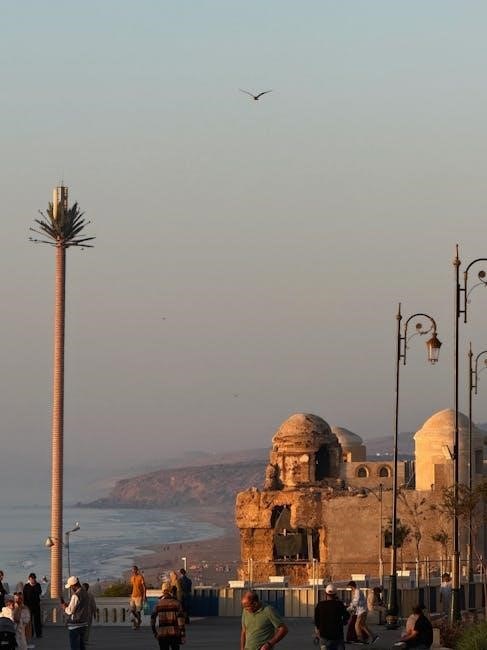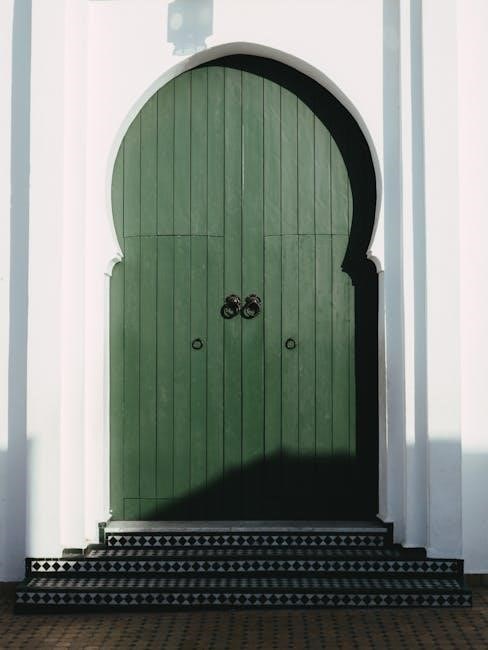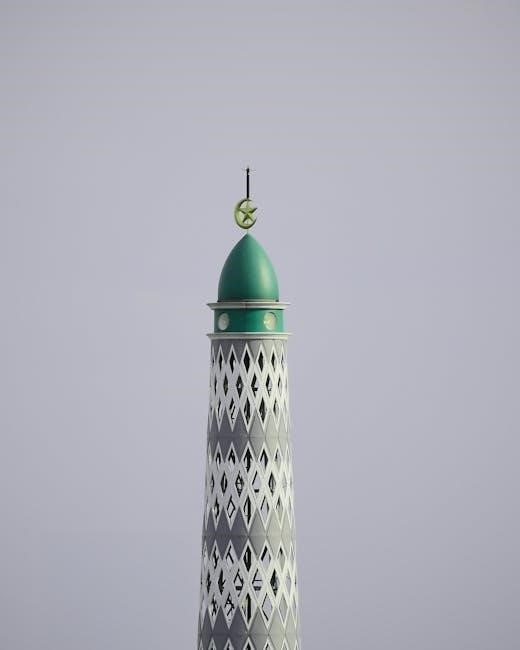Kriat Shema Al Hamita is a central Jewish prayer emphasizing divine unity and loyalty. This article explores its significance, structure, and deeper meanings, providing a comprehensive guide for understanding and recitation.
1.1. Overview of Kriat Shema
Kriat Shema, or the recitation of the Shema, is a foundational Jewish prayer declaring faith in God’s unity. It is rooted in biblical passages (Deuteronomy 6:4-9, Exodus 13:1-10, and Numbers 15:37-41) and serves as a declaration of loyalty to divine commandments. Recited twice daily, it is a cornerstone of Jewish worship, reflecting the covenant between God and the Jewish people. Its recitation fosters spiritual connection, reminding individuals of their commitment to faith and tradition. This section provides an overview of its significance and role in Jewish practice, setting the stage for deeper exploration in subsequent sections.
1.2. Importance of Al Hamita in Jewish Prayer
Al Hamita holds profound significance in Jewish prayer, serving as a declaration of faith and divine unity. Rooted in the Shema, it reinforces the belief in one God and the covenant with Israel. Its recitation is not merely a ritual but a deeply emotional and spiritual act, connecting the individual to the divine presence. Al Hamita also embodies trust in God’s protection, particularly in challenging times, making it a cornerstone of Jewish devotion and identity. Its inclusion in daily prayers underscores its enduring relevance and spiritual power.
1.3; Purpose of the Article
This article aims to provide a comprehensive understanding of Kriat Shema Al Hamita, exploring its historical significance, textual structure, and spiritual depth. By examining its origins, evolution, and role in Jewish tradition, readers will gain insights into its importance in daily prayer and its symbolic meanings. The article also seeks to address common questions and misconceptions, offering practical guidance for proper recitation and incorporation into personal worship. Ultimately, this guide serves as a resource for deepening one’s connection to the prayer and its timeless message of faith and divine unity.
Historical Background
The historical background of Kriat Shema Al Hamita traces its origins in Jewish scripture and its evolution over centuries, reflecting core beliefs and practices central to Jewish identity.
2.1. Origins of Kriat Shema
Kriat Shema, or the recitation of the Shema, traces its origins to the Torah, specifically Deuteronomy 6:4-9 and 11:13-21. These passages emphasize loving God and keeping His commandments. The practice of reciting the Shema dates back to the time of the Torah, around 600 BCE, as a daily affirmation of faith. It became a central component of Jewish prayer, particularly in the morning and evening services, symbolizing the acceptance of God’s sovereignty. Over time, it evolved into a structured liturgical practice, retaining its core purpose of reinforcing Jewish identity and devotion.
2.2. Evolution of Al Hamita in Jewish Liturgy
Al Hamita’s role in Jewish liturgy has evolved significantly over centuries. Originating in the Talmudic era, it was initially recited as a declaration of faith. Over time, its placement and emphasis shifted, becoming integral to the Kriat Shema. Medieval scholars further enriched its interpretation, linking it to divine protection and redemption. By the early modern period, Al Hamita was firmly established as a core component of daily prayers, reflecting its enduring theological and communal significance. Its evolution mirrors the dynamic nature of Jewish worship, adapting to historical and spiritual needs while retaining its essence.
2.3. Key Figures in the Development of Kriat Shema
The development of Kriat Shema has been shaped by influential Jewish scholars and leaders. Moses, as the receiver of the Torah, is central, as the Shema originates from Deuteronomy. Rabbi Akiva emphasized its recitation, while Maimonides codified its laws. The Vilna Gaon contributed to its textual accuracy. These figures, along with the Great Assembly, played pivotal roles in refining and establishing Kriat Shema as a cornerstone of Jewish prayer, ensuring its enduring relevance and observance across generations.

Structure of Kriat Shema Al Hamita
Kriat Shema Al Hamita consists of core biblical passages and surrounding blessings, structured to emphasize faith and divine sovereignty. Its organized format ensures a meaningful and focused recitation experience.

3.1. Core Texts and Passages
The core of Kriat Shema Al Hamita consists of three key biblical passages: Deuteronomy 6:4-9 (Shema Yisrael), Deuteronomy 11:13-21, and Numbers 15:37-41. These texts emphasize loyalty to God, the rewards of faithfulness, and the commandment to wear tzitzit as a reminder of divine mitzvot. Additionally, Deuteronomy 6:5 and 11:22 are central, reinforcing the obligation to love and follow God’s commandments. These passages form the spiritual and legal foundation of the prayer, serving as a declaration of faith and commitment to Jewish observance.
3.2. Order of Recitation
The recitation of Kriat Shema Al Hamita follows a specific order to ensure its meaningfulness and adherence to tradition. It begins with the blessings preceding the Shema, followed by the recitation of Deuteronomy 6:4-9, 11:13-21, and Numbers 15:37-41. The passages are recited in this sequence to reflect their theological significance. After the Shema, additional prayers and blessings are recited, depending on whether it is the morning or evening service. This structured order helps maintain focus and emphasizes the profound spiritual message embedded in the text.
3.3. Special Additions for Al Hamita
Al Hamita incorporates unique additions that distinguish it from the standard Kriat Shema. These include specific blessings and passages that emphasize divine protection and redemption. The recitation often concludes with a heartfelt plea for salvation, reflecting its protective nature. Additionally, Al Hamita includes the recitation of Shema Yisrael with heightened intention, underscoring the covenant between the Jewish people and God. These special elements are not found in the regular Shema, making Al Hamita a distinctive and meaningful prayer in Jewish tradition. Its additions deepen the spiritual connection and reinforce its role as a safeguarding blessing.

Translation and Interpretation
This section provides an English translation of Kriat Shema Al Hamita, along with interpretations of its key concepts and symbolic meanings, aiding deeper understanding and meaningful recitation.
4.1. English Translation of Kriat Shema
Kriat Shema, including Al Hamita, is traditionally recited in Hebrew, but its English translation conveys profound spiritual truths. The Shema begins with “Hear, O Israel: The Lord our God, the Lord is one,” affirming divine unity. It continues with verses from Deuteronomy, emphasizing love for God, remembrance of His commandments, and the oneness of creation. The translation captures the essence of devotion, obedience, and the covenant between God and His people, making it accessible for those who seek deeper understanding and connection to the prayer’s timeless message.
4.2. Hebrew Text with Transliteration
This section provides the Hebrew text of Kriat Shema Al Hamita alongside its transliteration into English. The transliteration aids those unfamiliar with Hebrew in accurate pronunciation, ensuring proper recitation. Each Hebrew passage is carefully transcribed using a standardized system, maintaining the original text’s integrity. This resource is invaluable for learners and those seeking to deepen their connection with the prayer. By offering both the original and transliterated versions, it bridges language barriers, making the prayer accessible to a broader audience while preserving its sacred tradition.
4.3. Key Concepts and Symbolism
Kriat Shema Al Hamita is rich in symbolism, emphasizing divine unity and the covenant between God and Israel. The number three recurs, representing the unity of God, Torah, and Israel. The Shema itself is a declaration of faith, while the additional passages highlight redemption and divine protection.
The Tefillin and Mezuzah symbolize the commandments to bind God’s words on the heart and doorposts. The phrase “Hear, O Israel” underscores collective responsibility and the acceptance of God’s sovereignty, while “Baruch Shem” expresses trust in divine redemption and protection.
The Role of Al Hamita
Al Hamita serves as a protective blessing within Kriat Shema, reinforcing trust in God’s presence and providence, offering spiritual safeguarding and deepening the connection with the divine.
5.1. Understanding Al Hamita in the Context of Kriat Shema
Al Hamita, a blessing within Kriat Shema, serves as a profound expression of trust in God’s protection and divine providence. Rooted in the Talmud, it emphasizes surrendering one’s soul to God, even in times of adversity. Recited after the first section of Shema, Al Hamita reinforces the Jewish people’s covenantal bond with God. Its placement underscores the theological connection between declaring God’s unity and seeking divine safeguarding. This blessing encapsulates the essence of faith, resilience, and reliance on the Almighty, making it a cornerstone of Jewish prayer and spirituality.
5.2. Significance of Al Hamita in Jewish Tradition
Al Hamita holds profound significance in Jewish tradition, serving as a declaration of faith and divine protection. It reinforces the belief in God’s unity and providence, offering comfort and strength to the faithful. The prayer is often recited in times of uncertainty, seeking refuge in divine mercy. Its inclusion in Kriat Shema underscores its importance in daily worship, fostering a deep spiritual connection. Al Hamita is also seen as a shield against harm, embodying the Jewish people’s enduring trust in God’s benevolence. Its recitation is a timeless expression of devotion and resilience.
Its significance extends beyond individual worship, as it unites Jews across generations in shared prayer and tradition. Al Hamita’s themes of faith and protection resonate universally, making it a cherished element of Jewish liturgy and identity. By reciting Al Hamita, one reaffirms their commitment to Jewish values and heritage, ensuring its legacy endures.
5.3. Al Hamita as a Protective Blessing
Al Hamita serves as a protective blessing, invoking divine guardianship and safety. Rooted in the Shema, it seeks refuge in God’s watchful care, reflecting trust in His providence. By reciting Al Hamita, one expresses faith in divine protection, drawing strength from biblical promises. This blessing is particularly meaningful in times of uncertainty, offering comfort and reassurance. Its themes of trust and deliverance resonate deeply, reinforcing the belief in God’s enduring presence and protection in all aspects of life.

Practical Guide to Recitation
Mastering Kriat Shema Al Hamita requires focus, proper pronunciation, and a sincere mindset. Use a guide to ensure accuracy, maintaining concentration throughout the recitation for deeper spiritual connection.
6.1. How to Recite Kriat Shema Al Hamita
To recite Kriat Shema Al Hamita, begin by washing your hands and dressing modestly. Find a quiet, respectful environment and maintain focus. Stand during the recitation, if possible, and ensure proper pronunciation. Recite the blessings before and after the Shema, emphasizing the declaration of faith in the unity of God. Pay attention to the words, understanding their meaning, and maintain intent to fulfill the biblical commandment. Concentrate on the verses, particularly Shema Yisrael, and avoid distractions to fully connect with the prayer’s significance.
6.2. Proper Pronunciation and Intonation

Proper pronunciation and intonation are vital for reciting Kriat Shema Al Hamita accurately. The Hebrew text requires attention to stress patterns, vowel sounds, and melodic intonation. Mispronouncing words like Shema (שְׁמַע) or Baruch (בָּרוּךְ) can alter meaning. Practice with a skilled cantor or recordings ensures authenticity. Pay special attention to guttural letters like chet (ח) and ayin (ע), which are unique to Hebrew. Intonation varies slightly between morning and evening recitations, so familiarize yourself with both. Using the provided PDF guide can help master these elements effectively.
6.3. Common Mistakes to Avoid
When reciting Kriat Shema Al Hamita, common mistakes include rushing through the text, mispronouncing Hebrew words, and skipping essential passages. Many individuals also fail to maintain proper focus, treating the recitation as a mere ritual rather than a meaningful expression of faith. Additionally, some may neglect to recite the blessings before and after, or they may omit the special additions unique to Al Hamita. To avoid these errors, practice the text slowly, use a guide for pronunciation, and ensure a mindful, intentional approach to the recitation.
Incorporating Kriat Shema into Daily Life
7.1. Morning and Evening Recitation
Consistent recitation of Kriat Shema in the morning and evening fosters spiritual mindfulness and connection to divine commandments, grounding one’s daily life in faith and intentionality.
7.2. Kriat Shema in Shema Yisrael
Al Hamita is integral to the Shema Yisrael prayer, reinforcing the affirmation of God’s unity and serving as a protective blessing amidst life’s challenges and uncertainties.
7.3. Using the PDF as a Study Tool
The PDF guide provides accessible Hebrew text, transliteration, and translations, aiding learners in mastering Kriat Shema and deepening their understanding of its profound spiritual significance.
Kriat Shema Al Hamita is traditionally recited twice daily, in the morning and evening, as part of Jewish prayer services. The morning recitation follows the Shema Yisrael, while the evening recitation is part of Maariv. Consistency in recitation strengthens spiritual connection and reinforces faith. The morning focuses on divine revelation, while the evening emphasizes trust in God’s protection. Proper timing and intention are essential, ensuring the recitation aligns with the prescribed hours. This daily practice fosters mindfulness and gratitude, embedding the principles of Kriat Shema deeply into one’s consciousness.

Kriat Shema is deeply intertwined with the broader prayer of Shema Yisrael, which is a cornerstone of Jewish daily worship. The Shema serves as a declaration of faith, affirming the unity of God and the commitment to follow His commandments. Within this framework, Kriat Shema Al Hamita is often recited to invoke divine protection and blessings, particularly in times of need. Its integration into Shema Yisrael underscores its role in strengthening spiritual connection and fostering a sense of community among worshippers. This fusion highlights the prayer’s dual purpose: personal devotion and collective affirmation of faith.
A PDF guide for Kriat Shema Al Hamita serves as an invaluable resource for learners and practitioners alike. Its portable format allows for easy access and study on various devices. The structured layout often includes clear Hebrew text, English translations, and transliterations, facilitating understanding and recitation. Many PDFs incorporate interactive features, such as bookmarks and search functions, enabling quick navigation. Additionally, they may include cultural and historical insights, enhancing the user’s appreciation of the prayer. Whether for personal study or communal use, a well-designed PDF is an essential tool for engaging deeply with Kriat Shema Al Hamita.

Cultural and Historical Insights

Kriat Shema Al Hamita holds profound cultural and historical significance, reflecting Jewish identity and resilience. Its recitation has bridged generations, fostering unity and spiritual connection across communities worldwide.
8.1. The Role of Kriat Shema in Jewish Communities
Kriat Shema has long been a unifying prayer in Jewish communities, fostering a collective connection to faith and tradition. Recited daily in synagogues and homes, it strengthens communal bonds and reinforces commitment to Torah values. Its inclusion in public services and private rituals ensures its accessibility to all, making it a cornerstone of Jewish identity. By teaching Kriat Shema to children, communities pass down cultural and religious heritage, ensuring its enduring relevance. This shared practice transcends individual worship, creating a sense of unity and resilience among Jews worldwide.
8.2. Historical Events Linked to Al Hamita
Al Hamita has been a cornerstone of Jewish prayer, with its roots tracing back to the Torah. The recitation of Shema is first mentioned in Deuteronomy and Numbers, making it a foundational element of Jewish practice. Historically, its recitation has been tied to moments of communal resilience, such as during the Maccabean revolt, where it symbolized resistance against religious oppression. Additionally, Al Hamita gained prominence during the Holocaust, where its recitation became a testament to faith amidst unimaginable suffering.
Over centuries, Al Hamita has been central to Jewish identity, with its inclusion in the Siddur formalized by early sages. Its enduring presence highlights its role as a unifying prayer across generations and circumstances, reinforcing its timeless significance in Jewish tradition.
8.3. Al Hamita in Modern Jewish Practice
Al Hamita remains a vital component of Jewish worship, blending tradition with contemporary practices. Today, it is often recited in synagogues and homes, fostering a sense of unity and spiritual connection. Many communities incorporate it into educational programs, ensuring its teachings are passed to younger generations. Additionally, digital resources like PDF guides have made Al Hamita more accessible, allowing individuals to study and recite it with greater ease. This integration of ancient prayer into modern Jewish life highlights its enduring relevance and adaptability in maintaining faith and cultural identity.
Common Questions and Misconceptions
This section addresses frequently asked questions about Kriat Shema Al Hamita, clarifies common misconceptions, and provides accurate insights into its meaning and practice in Jewish tradition.
9.1. FAQs About Kriat Shema
Common questions about Kriat Shema include its origins, significance, and proper recitation. Many wonder about its connection to daily Jewish practice and its role in expressing faith. Others inquire about the correct times for recitation and the importance of its specific passages. Additionally, questions arise about variations in different Jewish communities and the meaning of its blessings. These FAQs provide clarity on these topics, helping to deepen understanding and appreciation of this foundational prayer.
9.2. Clarifying Misunderstandings About Al Hamita
Some misconceptions surround Al Hamita, such as its purpose and significance. It is not merely a recitation but a profound declaration of faith and divine connection. Many mistakenly believe it is only for scholars, but it is accessible to all. Another misunderstanding is that Al Hamita is only about protection, when it also embodies love and devotion. This section addresses these misconceptions, emphasizing its universal relevance and deeper spiritual meaning. By clarifying these points, readers can better appreciate Al Hamita’s role in Jewish prayer and its enduring significance in daily life.
9.3. Addressing Controversies Surrounding the Prayer
Kriat Shema Al Hamita has occasionally been a subject of debate within Jewish communities. Some scholars question its historical origins, while others discuss its interpretation. Controversies arise from varying textual traditions and differing views on its role in liturgy. Additionally, debates emerge regarding its eschatological implications and its connection to mystical teachings. Despite these discussions, the prayer remains a unifying element, reflecting the community’s commitment to faith. Open dialogue and respect for diverse perspectives are essential in addressing these controversies, ensuring the prayer’s relevance and meaning endure.
Kriat Shema Al Hamita holds profound significance in Jewish faith, offering a deeply spiritual connection. This guide provides essential insights, encouraging further exploration and meaningful recitation of this sacred prayer.
10.1. Summary of Key Points
This article has explored the profound significance of Kriat Shema Al Hamita, delving into its historical roots, structural components, and spiritual Importance. It has examined the prayer’s role in Jewish tradition, its protective blessings, and its daily recitation practices. The guide has also provided insights into its cultural and historical context, addressed common questions, and emphasized the importance of preserving this sacred tradition. By understanding and incorporating Kriat Shema Al Hamita into daily life, individuals can deepen their connection to Jewish heritage and faith.
10.2. Final Thoughts on the Significance of Kriat Shema
Kriat Shema stands as a profound declaration of faith, reinforcing Jewish identity and unity. Its daily recitation connects believers to divine presence and shared traditions, transcending time and circumstance. Beyond ritual, it embodies a deep spiritual commitment, inspiring reflection on life’s purpose and humanity’s relationship with the divine. As a timeless prayer, Kriat Shema continues to nurture souls, offering solace, strength, and a sense of belonging to the Jewish community. Its enduring relevance invites all to embrace its wisdom and deepen their spiritual journey.
10.3. Encouragement for Further Study
Delve deeper into the richness of Kriat Shema Al Hamita by exploring its historical and spiritual dimensions. Use the provided PDF as a foundational tool for daily study and reflection. Engage with Jewish scholars, attend lectures, and join study groups to broaden your understanding. Regularly recite and meditate on the prayers to internalize their meaning. Embrace the journey of lifelong learning to enrich your spiritual practice and connection to Jewish heritage. Let curiosity and passion guide you in uncovering the profound significance of this sacred tradition.

Future Directions
Exploring innovative ways to preserve and share Kriat Shema Al Hamita, leveraging technology for education, and fostering intergenerational engagement to ensure its enduring relevance in modern Jewish practice.
11.1. Continuing the Study of Kriat Shema
Continuing the study of Kriat Shema Al Hamita involves deepening one’s understanding of its textual and spiritual dimensions. By exploring its historical roots, linguistic nuances, and theological significance, learners can uncover new layers of meaning. Engaging with classical commentaries, such as Rashi or Maimonides, alongside modern interpretations, enriches the learning experience. Regular review and reflection on the prayer’s themes, such as divine sovereignty and redemption, foster spiritual growth. Leveraging educational resources, like structured courses or study groups, ensures a comprehensive and ongoing connection to this foundational Jewish text.
11.2. The Role of Technology in Preserving Al Hamita
Technology plays a vital role in preserving and disseminating Kriat Shema Al Hamita. Digital platforms and PDF resources ensure accessibility, enabling global access to sacred texts. Apps and multimedia tools enhance learning, while virtual classrooms foster communal study. These innovations bridge tradition and modernity, safeguarding Al Hamita for future generations.
11.3. Passing the Tradition to Future Generations
Passing the tradition of Kriat Shema Al Hamita to future generations is a sacred responsibility. Education and family play pivotal roles in preserving this heritage. Parents and educators must instill the importance of the prayer, teaching its meaning and historical significance. Community engagement through youth programs and interactive learning materials, such as PDF guides, can deepen understanding. By fostering a love for Jewish traditions, we ensure the continuity of Kriat Shema Al Hamita, safeguarding its spiritual and cultural legacy for generations to come. Collective efforts are essential to keep this vital practice alive and thriving.
